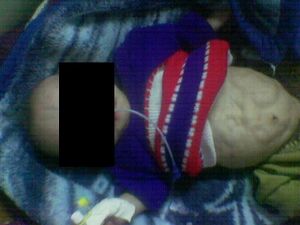Prune Belly Syndrome
Introduction[edit | edit source]
Prune belly syndrome (PBS), also known as Eagle-Barrett syndrome, is a rare and complex multisystem disorder that is characterized by incomplete or absent musculature of the abdominal wall, bilateral intra-abdominal cryptorchidism, and urinary tract anomalies such as megalourethra, megacystis, hydroureteronephrosis, and renal dysplasia[1].
Epidemiology[edit | edit source]
Prune belly syndrome (PBS) predominantly affects male infants, with an incidence of 3.8 per 100,000 live male births in the United States[2]. Females account for less than 5% of all PBS cases and typically present with an absent abdominal wall musculature and a dilated and abnormal urinary tract without any concurrent gonadal anomaly[3]. A genomic mutation in the HNF1β (hepatocyte nuclear factor) transcription factor has been identified in 3% of PBS cases[4]. HNF1β plays a crucial role in regulating gene expression necessary for mesodermal and endodermal development, and it is expressed in various tissues[4]. Although PBS is typically considered a sporadic condition, its high concordance rate in twins (12.2 per 100,000 live births), reports of monozygotic male twins with PBS, familial case reports, and the higher incidence of PBS in males suggest a genetic contribution. However, the occurrence of both discordance and concordance for PBS in monozygotic twins suggests that genetic mutations alone cannot entirely explain the pathogenesis of the syndrome.[5][6]
Clinical Presentation[edit | edit source]
Children with PBS may present with[1]
- Wrinkled, redundant skin with bulging at the flanks due to deficiency of abdominal wall musculature
- Prematurity
- Hydroureteronephrosis - dilation and enlargement of both the ureters and the kidneys
- Pulmonary hypoplasia - underdevelopment or incomplete growth of the lungs
- Cryptorchidism - One or both testicles fail to descend properly into the scrotum
- Vesicoureteral reflux – an abnormal flow of urine from the bladder back into the ureters and potentially reaching the kidneys
- Megaureter/megacystis - abnormally enlarged or dilated ureter/bladder
- Clubfoot
Classification of Prune Belly Syndrome[edit | edit source]
Woodard[7] proposed a classification system for Prune Belly Syndrome (PBS) that divides children with PBS into three major categories based on their antenatal and anatomical features:
Category I: Children in this category exhibit pronounced oligohydramnios resulting from renal dysplasia and/or outlet obstruction, leading to severe pulmonary hypoplasia and skeletal abnormalities. These neonates often have a poor prognosis and may die within a few days of birth. They may exhibit Potter's facies, which are characterised by micrognathia, wide-set eyes, flattened palpebral fissures, prominent epicanthus, flattened nasal bridge, low-set ears lacking cartilage, and skeletal deformities. Urethral atresia cases are typically classified as Category I.
Category II: Children in this category have the classic features of PBS, and their prognosis is influenced by the degree of renal dysplasia present. There is a wide variation in the degree of renal dysplasia in this category, with severe forms requiring early dialysis. Pulmonary hypoplasia is not a prominent feature.
Category III: Children in this category exhibit mild triad features or incomplete forms of PBS, and their renal function is usually normal or mildly impaired. They do not exhibit pulmonary insufficiency.
Diagnosis[edit | edit source]
Ultrasound examination at 11 to 14 weeks of gestation can potentially identify prune belly syndrome. Ultrasound findings suggestive of prune belly syndrome include hydroureter, bilateral hydro nephrosis, urinary bladder wall thickening, musculoskeletal abnormalities, and oligohydramnios. If the manifestations of PBS are not markedly severe, it may not be feasible to detect the condition prenatally, and diagnosis can only be established postnatally (after birth) due to the presence of similar characteristics in various urinary malformations.[8]
Management / Interventions[edit | edit source]
The management of Prune Belly Syndrome (PBS) in children poses a significant challenge, necessitating timely and specialized care involving a multidisciplinary team, including a neonatologist, physiotherapist, urologist, and nephrologist, with additional involvement of cardiologists and orthopaedic specialists when indicated. A comprehensive approach to care is essential to address the complex medical needs associated with PBS and ensure optimal outcomes for affected children.[1]
Surgical Management
The surgical intervention for Prune Belly Syndrome (PBS) requires an individualized approach that considers the specific characteristics of each case, as well as the timing and methodology of the surgical procedure. The surgical management of PBS includes orchiopexy (a procedure to help the testicles descend into the scrotum), abdominal wall reconstruction (abdominoplasty), ureterostomy, urinary tract reconstruction, or kidney transplantation.[8]
Physiotherapy Management
Differential Diagnosis[edit | edit source]
Resources[edit | edit source]
https://www.youtube.com/watch?v=ncSgH2kKUIg
References[edit | edit source]
- ↑ 1.0 1.1 1.2 Arlen AM, Nawaf C, Kirsch AJ. Prune belly syndrome: current perspectives. Pediatric health, medicine and therapeutics. 2019 Aug 6:75-81.
- ↑ Routh JC, Huang L, Retik AB, Nelson CP. Contemporary epidemiology and characterization of newborn males with prune belly syndrome. Urology. 2010 Jul 1;76(1):44-8.
- ↑ Lloyd JC, Wiener JS, Gargollo PC, Inman BA, Ross SS, Routh JC. Contemporary epidemiological trends in complex congenital genitourinary anomalies. The Journal of urology. 2013 Oct 1;190(4):1590-5.
- ↑ 4.0 4.1 Granberg CF, Harrison SM, Dajusta D, Zhang S, Hajarnis S, Igarashi P, Baker LA. Genetic basis of prune belly syndrome: screening for HNF1β gene. The Journal of urology. 2012 Jan;187(1):272-8.
- ↑ Petersen DS, Fish L, Cass AS. Twins with congenital deficiency of abdominal musculature. The Journal of Urology. 1972 Apr;107(4):670-2.
- ↑ Balaji KC, Patil A, Townes PL, Primack W, Skare J, Hopkins T. Concordant prune belly syndrome in monozygotic twins. Urology. 2000 Jun 1;55(6):949.
- ↑ Woodard JR. The prune belly syndrome. Urologic Clinics of North America. 1978 Feb 1;5(1):75-93.
- ↑ 8.0 8.1 Keet K, Henry BM, Tubbs RS. Prune-belly syndrome in Africa: An analysis and systematic review of cases, etiology, treatment, and outcomes. Journal of Clinical Urology. 2021 Sep;14(5):369-84.







